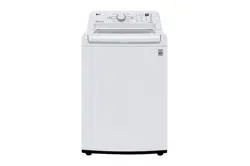Documents: Go to download!
User Manual
- User Manual - (English, French, Spanish)
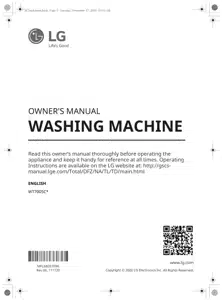
OWNER'S MANUAL WASHING MACHINE
PRODUCT OVERVIEW
Product Features
The images in this guide may be different from the actual components and accessories, which are subject to change by the manufacturer without prior notice for product improvement purposes.
NOTE: For your safety and for extended product life, use only authorized components. The manufacturer is not responsible for product malfunction, property damage or bodily injury caused by the use of separately purchased unauthorized components, parts, or non-LG products.
Front View

- Lid
- Control Panel
- Detergent Dispenser Drawer
- Liquid Bleach Compartment
- Tub
- Leveling Feet
Rear View

- Water Inlets
- Power Cord
- Drain Hose
Product Specifications

INSTALLATION
PRODUCT OVERVIEW
Product Features
The images in this guide may be different from the actual components and accessories, which are subject to change by the manufacturer without prior notice for product improvement purposes.
NOTE: For your safety and for extended product life, use only authorized components. The manufacturer is not responsible for product malfunction, property damage or bodily injury caused by the use of separately purchased unauthorized components, parts, or non-LG products.
Front View
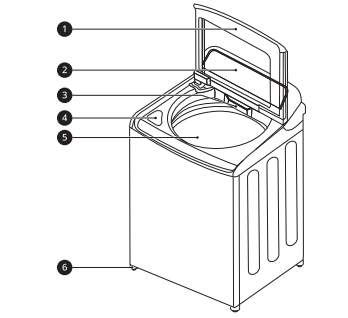
- Lid
- Control Panel
- Detergent Dispenser Drawer
- Liquid Bleach Compartment
- Tub
- Leveling Feet
Rear View

- Water Inlets
- Power Cord
- Drain Hose
Product Specifications
The appearance and specifications listed in this manual may vary due to constant product improvements.

INSTALLATION
Before Installing
- Moving or installation of the appliance requires two or more people. Failure to follow these instructions may result in injury.
- Store and install the appliance where it will not be exposed to temperatures below freezing or exposed to outdoor weather conditions. Failure to follow this warning can cause product or part failure, serious injury, fire, electric shock, or death.
- Properly ground the washer to conform with all governing codes and ordinances. Failure to follow this warning can cause serious injury, fire, electric shock, or death.
- To reduce the risk of electric shock, do not install the appliance in humid spaces. Failure to follow this warning can cause serious injury, fire, electric shock, or death.
- To ensure proper airflow, do not block the large opening on the bottom of the washer with carpeting or other materials.
- Do not remove the ground prong from the power cord. Do not use an adapter or extension cord. Plug into a grounded 3-prong outlet. Failure to follow this warning can cause serious injury, fire, electric shock, or death.
- Certain internal parts are intentionally not grounded and may present a risk of electric shock only during servicing. Service personnel - Do not contact the following parts while the appliance is energized: pump, motor, noise filter cover, and heater (on applicable models).
Installation Overview
Please read the following installation instructions first after purchasing this washer or transporting it to another location.
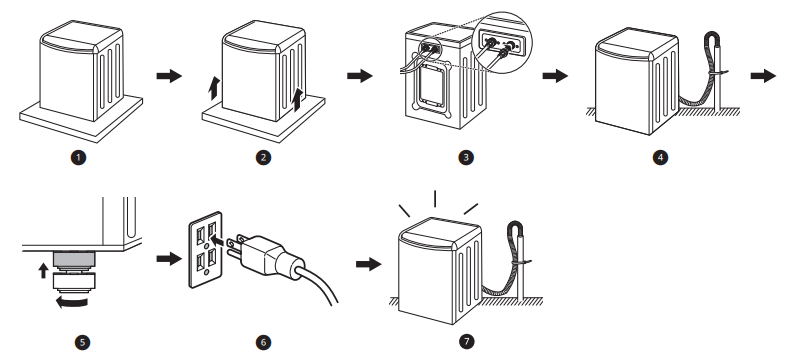
- Choosing the Proper Location
- Unpacking and Removing Shipping Material
- Connecting the Water Inlet Hoses
- Connecting the Drain Hose
- Leveling the Washer
- Connecting to the Power Supply
- Final Installation Check
Choosing the Proper Location
How to Connect the Water Inlet Hoses
1. Check the fittings and seals. Inspect the threaded fitting on each hose and make sure there is a rubber seal 1 in place in both ends of each hose to prevent leaking.
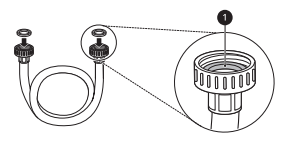
2. Connect the water supply hoses.
- Connect the water inlet hoses to the hot and cold water faucets tightly by hand and then tighten another 2/3 turn with pliers
- Connect the blue hose to the cold water faucet and the red hose to the hot water faucet

3. After the hoses are connected, turn on the water faucets and flush out any foreign substances such as dirt, sand, or sawdust. Let the water drain into a bucket, and check the water temperature to make sure you’ve connected the hoses to the correct faucets.
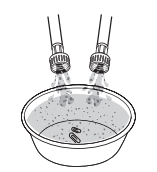
4. Attach the inlet hoses to the back of the washer.
- Attach the hot water inlet hose to the hot water inlet on the back of the washer. Attach the cold water inlet hose to the cold water inlet on the back of the washer.
- Tighten the fittings securely. Turn on both faucets all the way and check for leaks at both ends of the hoses.
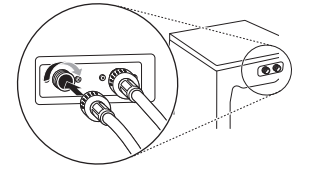
.
Installation Check Error Codes
Error Code
- Fully open the water faucet.
- Straighten out any kinks in the inlet hoses and make sure the hoses are not pinched against the wall or under the washer
Error Code
- Straighten out any kinks in the drain hose and make sure the hose is not pinched against the wall or under the washer.
- Remove and flush out the drain hose to remove clogs.
- Adjust or repair the drain. Maximum drain height is 96 inches.
OPERATION
Operation Overview
- Sort laundry and load the washer. • Sort laundry by fabric type, soil level, color and load size, as needed. Open the lid and load items into the washer. • If using single-use detergent packs, or gel or tablet detergents, place them in the tub before loading the laundry.
- Add cleaning products. • Add the proper amount of HE (HighEfficiency) detergent to the detergent dispenser. • If desired, add bleach or fabric softener to the appropriate dispensers. • Do not place liquid or powdered detergent packs, or gel or tablet detergents in the dispenser.
- Turn on the washer. • Press the Power button to turn on the washer. • The lights above the cycle buttons will illuminate and a chime will sound.
- Select a cycle. • Turn the cycle selector knob or press the cycle buttons repeatedly until the desired cycle is selected. • The preset wash temperature, spin speed, soil level and option settings for the selected cycle are shown. • The Normal cycle must be selected in order to change its default settings. • Pressing the Start/Pause button without selecting a cycle immediately starts the Normal cycle with the default settings.
- Adjust settings. • Default settings for the selected cycle can be changed, if desired, using the cycle modifier and option buttons. • Not all modifiers and options are available on all cycles. A different chime sounds and the LED does not light up if the selection is not allowed.
- Begin cycle. • Press the Start/Pause button to begin the cycle. The lid locks, and the washer agitates briefly without water to measure the weight of the load. • If the Start/Pause button is not pressed within a certain time, the washer shuts off and all settings are lost.
- If necessary, add additional items to the tub while the Add Garment light is on. • This light turns on at the beginning of the wash cycle to indicate when it is safe to add items to the tub. • Press the Start/Pause button to pause the cycle and add items to the tub. Press the Start/Pause button to resume the cycle. • Adding items after the Add Garment light turns off may result in poor wash performance.
- End of cycle. • When the cycle is finished, a melody sounds. Immediately remove the clothing from the washer to reduce wrinkling. • If the washer includes lint filters, remember to check lint filters after every 2 to 3 loads.
Sorting Laundry
CAUTION
- The washer can be fully loaded, but the tub should not be tightly packed with items. The lid of the washer should close easily.
- Use the Bedding cycle for buoyant or nonabsorbent items such as pillows or comforters. Failure to follow this caution can result in leakage.
- Clothing or articles that are waterproof or water resistant must be washed in the Waterproof cycle only. (Examples include water resistant clothing, mattress covers, outdoor clothes, and plastic mats.) Using another cycle may result in personal injury or damage to the washer, clothes, walls, floor, and surrounding objects due to abnormal vibration.
Grouping Similar Items
For the best washing results, and to reduce the possibility of damage to clothing, sort clothing into loads made up of similar items. Mixing different fabric types and/or soil levels can result in poor wash performance, color transfer, discoloration, fabric damage or linting. Fabrics should be sorted into groups as described below.
Colors Sort articles by color. Wash dark clothes separately from light colors or whites. Mixing dark clothes with light clothes can result in dye transfer or discoloration of the lighter clothes.
Soil Level Wash heavily soiled clothing together. Washing lightly soiled clothing in the same load with heavily soiled clothing could result in poor wash performance for the lightly soiled clothing. Fabric Type Delicate articles should not be mixed with heavy or sturdy fabric types. Washing heavy fabrics with delicates can result in poor wash performance for the heavy fabrics and possible damage to the delicates.
Lint Type Some fabrics attract and bind lint to them while others give off lint in the laundry process. Avoid mixing these lint collectors and lint producers in the same load. Mixing these fabrics will result in pilling and linting on the lint collectors. (For example, lint collector - knit sweater; lint producer - terry cloth towels.)
Loading the Washer
General Tips
- Check and empty pockets. Paper clips, coins, matches, etc. can damage clothing and the washer.
- Close zippers and hooks, and tie drawstrings to prevent snagging or tangling of clothes.
- Pretreat heavily stained areas for best results.
- Brush off heavy soil, dust, and hair from items before washing. Excess dirt or sand can abrade other fabrics and lead to poor wash performance.
- Combine large and small items in the tub. Load large items first. Large items should not be more than half of total load.
- For best results, load dry items only. If washing very wet items, wring out excess water before loading, or run a Spin Only cycle to extract excess water before adding detergent and starting the desired cycle.
- The washer can be fully loaded, but the tub should not be tightly packed with items. The lid of the washer must close easily.
- The washer will not fill or operate with the lid open.
- Do not overload the tub. Clothes should fit loosely in the tub under the maximum fill line (1). Loading clothes over the fill line may result in damage to clothing and the washer.
- Do not press down on items while stacking them in the tub.
- Load clothes loosely, and do not overfill the tub. Clothes need room to circulate in order to get clean.
Bulky Items
- Do not wash entire pillows or cushions. Remove pillow or cushion inserts and wash the covers only.
- Use the Bedding cycle for large or bulky items such as poly-filled jackets, comforters, pillows, etc. These items may not be as absorbent as other laundry items and should be sorted into a separate wash load for best performance.
- Bulky items should be placed as far down in the tub as possible for best performance. Always place buoyant items at the bottom of the tub. The washer will automatically detect the load size. Because of the high efficiency wash system, the water level may not completely cover the load.
Small Items
- Do not wash a single small item. Add enough similar items to the load to prevent an out-ofbalance load.
- Wash small, light items in a mesh bag. Small items can get caught in the impeller at the bottom of the tub, and brassiere hooks can damage other items or the tub.
MAINTENANCE
Regular Cleaning
Care after Wash
After the cycle is finished, wipe the lid and the inside of the lid seal to remove any moisture.
- Wipe the body of the washer with a dry cloth to remove any moisture.
- Leave the lid open to dry the tub interior.
NOTE: Make sure children and pets do not climb into the tub. Engage the Control Lock feature if needed to prevent children from accidentally starting a wash cycle.
Cleaning the Exterior
Proper care of your washer can extend its life.
Lid:
- Wash with a damp cloth on the outside and inside and then dry with a soft cloth.
Exterior:
- Immediately wipe off any spills.
- Wipe with a damp cloth.
- Do not touch the surface or the display with sharp objects.
Periodic Maintenance
- Use a towel or soft cloth to wipe around the washer lid opening and lid glass.
- Always remove items from the washer as soon as the cycle is complete. Leaving damp items in the washer can cause wrinkling, color transfer, and odor.
- Run the Tub Clean cycle once a month, or more often if needed, to remove detergent buildup and other residue.
Cleaning the Tub
Over time, residue may build up in the tub, leading to mildew or a musty odor. Run the Tub Clean cycle monthly to remove residue and prevent odor.
1. Remove any clothing from the tub.
2. Adding cleaning agents.
Cleaner | Instructions |
| Tub cleaner | Follow manufacturer’s recommendations. |
| Lime scale remover | |
| Liquid chlorine bleach | Add to main wash liquid detergent dispenser. |
| Powdered cleaner | Follow manufacturer’s recommendations. |
| Cleaning tablets | Place directly into the washer tub. |
- For other tub cleaning products, follow the cleaner manufacturer’s instructions and recommendations.
- Do not exceed the maximum fill line when adding bleach or powdered cleaners. Powdered cleaners may remain in the tub after cleaning.
3. Close the lid and press the Power button to turn on the washer.
4. Turn the knob or press the cycle buttons to select the Tub Clean cycle then press the Start/Pause button to begin the cycle.
5. After the cycle ends, open the lid and allow the tub interior to dry completely.
Removing Mineral Buildup
In areas with hard water, mineral scale can form on internal components of the washer. Periodically clean the mineral buildup on the internal components to extend the lifespan of the washer. Use of a water softener is recommended in areas with hard water.
- Use a descaler to remove visible mineral buildup on the washer tub.
- After descaling, always run the Tub Clean cycle before washing clothing.
- Mineral scale and other spots may be removed from the stainless steel tub using a soft cloth soaked in stainless steel cleaner.
- Do not use steel wool or abrasive cleaners
Leaving the Lid Open
After you finish using the washer, leave the lid open overnight to allow air to circulate and dry the tub. This helps prevent odors.
Cleaning the Dispenser Drawer
Detergent and fabric softener may build up in the dispenser drawer. Remove the drawer and inserts and check for buildup once or twice a month.
1. Turn off the washer, and unplug the power cord.
2. Remove the drawer by pulling it straight out until it stops. Lift the front of the drawer upwards and pull it completely out.
3. Remove the inserts from the two compartments.
4. Clean the inserts and drawer with warm water.
- Use a soft cloth or brush to clean and remove any residue.
- Do not use soap when cleaning the drawer and inserts.
5. Wipe off any moisture with a dry towel or cloth after cleaning.
6. To clean the drawer opening, use a small, non-metal brush to clean the recess. Remove all residue from the upper and lower parts of the recess.
7. Return the inserts to the proper compartments and replace the drawer.
- Set the drawer into the opening at an angle, then lower it and slide it into place.
Cleaning the Bleach Dispenser
Bleach may build up on the bleach dispenser cover. Check for buildup and clean the cover once or twice a month.
Automatic Bleach Dispenser Remove the cover from the bleach dispenser. Clean the cover and the opening with warm water.
Immediate Bleach Dispenser The cover cannot be separated from the dispenser. Clean the cover using a brush and warm water.
Cleaning the Water Inlet Filters
If the washer does not fill properly, an error message will appear on the display. The inlet valve filter screens could be clogged by hard water scale, sediment in the water supply, or other debris.
1. Turn off the washer, and unplug the power cord.
2. Turn off hot and cold water faucets.
3. Unscrew the hot and cold water hoses from the back of the washer.
4. Remove the filters from the water valves carefully.
- Use pliers to pull out the filters from the water valves.
5. Remove foreign objects and soak the filters in white vinegar or a lime scale remover.
- If using a lime scale remover, follow the manufacturer’s instructions. Be careful not to damage the filters while cleaning them.
6. Rinse filters thoroughly and press them back into place.
7. Flush then reattach the water hoses.
- Before reattaching the water inlet hoses, flush them by running several gallons of water through them into a bucket or drain, preferably with the faucets wide open for maximum flow.
Care in Cold Climates
Storing the Washer
If the washer will not be used for an extended period of time and is in an area that could be exposed to freezing temperatures,follow these steps to protect the washer from damage.
1. Turn off the washer, and unplug the power cord.
2. Turn off the water faucets.
3. Disconnect hoses from water supply and drain water from hoses.
4. Plug the power cord into a properly grounded electrical outlet.
5. Add 1 gallon of nontoxic recreational vehicle (RV) antifreeze to the empty tub and close the lid.
- Never use automotive antifreeze.
Turn on the washer and select the Spin cycle.
7. Press the Start/Pause button to start the drain pump for 1 minute.
- This will expel some of the antifreeze, leaving enough to protect the washer from damage.
8. Turn off the washer and unplug the power cord.
9. Dry the tub interior with a soft cloth, and close the lid.
10. Store the washer in an upright position.
11. Remove the inserts from the dispenser. Drain any water in the compartments and let them dry.
12. To remove the antifreeze from the washer after storage, run a Speed Wash cycle using detergent.
- Do not add laundry to this cycle.
When the Water Inlet Hoses are Frozen
- Turn off the washer, and unplug the power cord.
- Turn off the faucets connected to the water inlet hoses.
- Pour hot water on the frozen faucets to thaw the water inlet hoses and remove the water inlet hoses.
- Immerse the water inlet hoses in hot water to thaw them.
- Reconnect the water inlet hoses to the water inlets of the washer and to the faucets. See Connecting the Water Inlet Hoses for details.
- Turn on the faucets.
- Press the Power button to turn on the washer.
- Press and hold the Spin button for 3 seconds to operate Spin Only cycle for draining and spinning.
- Press the Start/Pause button and check that the water fills properly
When the Drain Hose is Frozen
- Pour hot water in the washer tub and close the lid.
- Wait for 1 - 2 hours. 3 Press the Power button to turn on the washer.
- Press and hold the Spin button for 3 seconds to operate Spin Only cycle for draining and spinning.
- Press the Start/Pause button to make sure the water drains.
TROUBLESHOOTING
Error Messages
Problem | Possible Cause & Solution |
UE UNBALANCE ERROR | The load is too small. • Add additional items to allow the washer to balance the load. |
Heavy articles are mixed with lighter items. • Always try to wash articles of somewhat similar weight to allow the washer to evenly distribute the weight of the load for spinning. | |
The load is out of balance. • Manually redistribute the load if articles have become tangled, preventing the automatic rebalancing from working properly. | |
IE INLET ERROR | Water supply faucets are not fully open. • Make sure that the water faucets are fully open. |
Water inlet hoses are kinked, pinched, or crushed. • Make sure that the hoses are not kinked, pinched or crushed behind or under the washer. Be careful when moving the washer during cleaning or maintenance. | |
Water inlet filters are clogged. • Clean the inlet filters. See MAINTENANCE. | |
Water supply pressure to faucet or house is too low. • Check another faucet in the house to make sure that household water pressure is adequate and flow is not restricted. • Disconnect the water inlet hoses from the washer and run a few gallons of water through the hoses to flush out any dirt. • If flow is too low, contact a plumber to have the water supply lines repaired. | |
Water supply connected with leak-limiting hoses. • The use of hoses designed to limit leaks is not recommended. Leak-limiting hoses can trip falsely and prevent the washer from filling. | |
DE WATER OUTLET ERROR | Drain hose is kinked, pinched, or clogged. • Make sure that the drain hose is free of clogs or kinks and is not pinched behind or under the washer. |
The end of the drain hose is more than 96 inches (2.4 m) above the bottom of the washer. • Move the end of the drain hose so that it is lower than 96 inches (2.4 m). | |
CL CONTROL LOCK FUNCTION | The control lock function is on to prevent anyone from changing cycles or operating the washer. • Turn off the control lock function in the control panel. See Control Lock under Options and Extra Functions. |
dr DRAIN FEATURE | Special drain feature • If the washer is paused during a cycle for more than 4 minutes, the cycle will be canceled and any water remaining in the tub will be drained. • This is not an error code. It indicates that the drain function is operating. |
dE LID ERROR | Lid is not closed properly. • Close the lid properly. • If the lid is closed and this error message is still displayed, call for service. |
dL LID LOCK ERROR | Lid is not locked properly. • Make sure that the lid is closed properly and press the Start/Pause button. You can hear the locking sound to lock the lid in the beginning of the cycle. The washer will not operate unless the lid is locked. • Make sure that nothing is caught under the lid, including shipping material or clothing. • Make sure that the latch mechanism is fully retracted.Make sure that the latch mechanism is fully retracted. • If the lid is closed and this error message is still displayed, call for service. |
LE 1 FOREIGN OBJECT ERROR | Foreign objects such as coins, pins, clips, etc., are caught between the pulsator and the inner tub. • Turn the washer off then on again. Press the Spin button without selecting a cycle to drain and spin the load. • When the Spin cycle is completed, empty the tub and find and remove any objects caught in the pulsator. • Always check pockets, etc., before washing to prevent error codes or damage to the washer or clothing. |
tcL TUB CLEAN ALARM | It is time to run the Tub Clean cycle. • This is not an error code. It indicates that the Tub Clean cycle is running or needs to be run to clean the washer tub. • For some models, tc is displayed first, then the L is displayed. |
ub UNBALANCE DETECTION | The washer has detected an out of balance load. • This display is for your information only, and no action is required. If the washer detects a load that is too far out of balance to spin, it will display this code while it is attempting to rebalance the load. The washer will add water and try to redistribute the load automatically. • As a result, the cycle will take longer than initially estimated. |
tE TEMPERATURE SENSOR ERROR | Control error • Unplug the washer and wait 60 minutes. Reconnect power and try again. • If the error code is still displayed, call for service. |
FE OVERFLOW ERROR | Water level is too high due to a faulty water valve. • Close the water faucets, unplug the washer, and call for service. |
PE PRESSURE SENSOR ERROR | The water level sensor is not working correctly. • Close the water faucets, unplug the washer, and call for service. |
LE MOTOR LOCKED ERROR | A motor error has occurred. • Allow the washer to stand for 30 minutes and then restart the cycle. • If the error code is still displayed, call for service. |
Eb CLUTCH ERROR | Clutch error • Mechanical failure • Unplug the washer and call for service. |
Noise
Problem | Possible Cause & Solution |
Clicking | Lid lock sounds when the lid locks or unlocks. • Normal operation |
Spraying or hissing | Water spraying or circulating during the cycle • Normal operation |
Humming or Gurgling | Drain pump is pumping water from the washer at times during a cycle. • Normal operation |
Water sloshing | A liquid in the balance ring around the pulsator helps the basket spin smoothly. • Normal operation |
Water being added after the washer has already begun to operate | The washer adapts to the load size and type to add more water to the cycle as needed. • Normal operation |
The wash load may be unbalanced. If the washer senses that the load is unbalanced, it will stop and refill to redistribute the load. • Normal operation | |
The washer may be diluting laundry additives to add to the wash load. • Normal operation | |
Rattling and clanking noise | Foreign objects, such as keys, coins, or safety pins may be in tub or pump. • Stop the washer, check the tub and the drain filter for foreign objects. • If noise continues after the washer is restarted, call for service. |
Thumping sound | Heavy wash loads may produce a thumping sound. • This is normal, but if the sound continues, the washer is probably out of balance. Stop and redistribute wash load. |
Wash load may be out of balance. • Pause the cycle and redistribute the load after the lid unlocks. | |
Vibrating noise | Packaging materials were not removed. • See Unpacking and Removing Shipping Material in INSTALLATION. |
Wash load may be unevenly distributed in the tub.Wash load may be unevenly distributed in the tub. • Pause the cycle and redistribute the load after the lid unlocks. | |
Not all leveling feet are resting firmly and evenly on the floor. • See Leveling the Washer in INSTALLATION. | |
Floor is not rigid enough. • Make sure that the floor is solid and does not flex. See Flooring in INSTALLATION. | |
Squeaking noise | Packaging materials were not removed. • See Unpacking and Removing shipping Material in INSTALLATION. |
Banging noise when the washer is filling with water.(Water hammer) | Plumbing in the home moves or flexes when the water valves in the washer shut off. • Water hammer is not caused by a defect in the washer. Install water hammer arrestors (purchased separately at hardware or home improvement store) between the fill hose and the washer for best results. |
Household water supply pressure is very high. • Adjust household water supply regulator to a lower pressure or contact a plumber. |
Operation
Problem | Possible Cause & Solution |
Water Leaking | Hoses are not connected correctly. • Check hoses and connectors for leaks, cracks, and splits. • Check and tighten hose connections. |
House drain pipes are clogged. • The washer pumps out water very rapidly. Check for water backing up out of the drain pipe during drain. If water is seen coming out of the drain, check for proper drain hose installation and check for restrictions in the drain. • Contact a plumber to repair drain pipe. | |
Drain hose has come out of the drain connector or is not inserted far enough. • Tie drain hose to inlet hose or standpipe to prevent it from coming out during drain. • For smaller drain pipes, insert the drain hose into the pipe as far as the drain hose flange. For larger drain pipes, insert the drain hose into the pipe 1 - 2 inches past the flange. | |
A large item such as a pillow or blanket is above the top of the tub. • Use the Bedding cycle for large or bulky items. Use extra care and never wash more than half a load of items that float, such as pillows. • Stop the washer and check the load. Make sure that the load does not crest above the top edge of the tub. | |
Oversudsing of detergent • Oversudsing may create leaks, and may be caused by the type and amount of detergent used. HE (High-Efficiency) detergent is the only detergent recommended. The normal amount of detergent to use is 1/4 to 1/2 of the maximum amount recommended by the detergent manufacturer. • Always reduce the amount of detergent if the load is small or lightly soiled, or if the water is very soft. • Never use more than the maximum amount recommended by the detergent manufacturer. | |
Excessive sudsing | Too much detergent or incorrect detergent • HE detergents are formulated specifically for HE (High-Efficiency) washers and contain suds reducing agents. Only use detergent with the HE (High-Efficiency) logo. • For detergent quantities refer to Detergent Use in OPERATION. If sudsing or detergent residue continues to be an issue, add an extra rinse. |
Washer will not turn on. | Power cord is not properly plugged in. • Make sure that the plug is plugged securely into a grounded, 3-prong, 120-VAC, 60 Hz outlet. |
House fuse is blown, circuit breaker has tripped, or power outage has occurred. • Reset circuit breaker or replace fuse. Do not increase fuse capacity. If the problem is a circuit overload, have it corrected by a qualified election. | |
Wash cycle time is longer than usual. | The washer automatically adjusts the wash time for the amount of laundry, water pressure and other operating conditions. • This is normal. The washer adjusts cycle time automatically to provide optimal results for the selected cycle. The time remaining shown in the display is only an estimate. Actual time may vary. |
Incomplete or no dispensing of detergent | Detergent compartments clogged from incorrect filling. • Make sure that detergent and additives are put into the correct dispenser compartments. • For all detergent types, always make sure that the dispenser drawer is fully closed before the start of the cycle. |
Too much detergent used. • Make sure that the suggested amount of detergent is used according to the manufacturer's recommendations. You may also dilute the detergent with water to the maximum fill line on the compartment to avoid clogging. Use only HE (High-Efficiency) detergent. - Always use as little detergent as possible. HE (High-Efficiency) washers need very little detergent to achieve optimum results. Using too much detergent will cause poor wash and rinse performance and may contribute to odors in the washer. | |
Insufficient water supply • Make sure that both hot and cold water faucets are turned on all the way. | |
Normal residue • It is normal for a small amount of detergent to remain in the dispenser. If this residue builds up, it can interfere with normal dispensing of detergents. Refer to the cleaning instructions. | |
Washer will not operate. | Control panel has powered off due to inactivity. • This is normal. Press the Power button to turn on the washer. |
Washer is unplugged. • Make sure that the power cord is plugged securely into an electrical outlet. | |
Water supply is turned off. • Turn both hot and cold faucets fully on. | |
Controls are not set properly. • Make sure that the cycle was set correctly, close the lid and press the Start/Pause button to start the wash cycle. | |
Lid is open. • Close the lid and make sure that noting is caught under the lid preventing it from closing completely. | |
Circuit breaker/fuse is tripped/blown. • Check house circuit breakers/fuses. Replace fuses or reset breaker. The washer should be on a dedicated branch circuit. | |
Start/Pause button was not pressed after the cycle was set. • Press the Power button then reselect the desired cycle and press the Start/Pause button. If the Start/Pause button is not pressed within a certain time, the washer will be turned off. (The time varies by model, from 4 to 60 minutes.) | |
Extremely low water pressure. • Check another faucet in the house to make sure that household water pressure is adequate. | |
Washer is too cold. • If the washer has been exposed to temperatures below freezing for an extended period of time, allow it to warm up before pressing the Power button. Otherwise, the display will not come on. | |
Washer is not filling properly. | Filter is clogged. • Make sure that inlet filters on the fill valves are not clogged. Refer to Cleaning the Water Inlet Filters in MAINTENANCE. |
Inlet hoses may be kinked. • Check that inlet hoses are not kinked or clogged. | |
Energy efficiency • This is a High-Efficiency (HE) washer. As a result, the water level settings for this washer may be different than for conventional washer. | |
Insufficient water supply • Make sure that both hot and cold water faucets are turned on all the way. | |
Washer lid is open. • Close the lid and make sure that nothing is caught under the lid preventing it from closing completely. | |
Water level is too low. • The water will not normally cover the clothes. The fill level is optimized for the wash motion to achieve the best wash performance. | |
Water in the washer does not drain or drains slowly. | Drain hose is kinked, pinched, or clogged. • Make sure that the drain hose is free of clogs or kinks and is not pinched behind or under the washer. |
The end of the drain hose is more than 96 inches (2.4 m) above the bottom of the washer. • Move the end of the drain hose so that it is lower than 96 inches (2.4 m). | |
Bleach does not dispense. | Bleach dispenser cover is not properly installed (on some models). • Make sure that the bleach cover is properly installed and snapped into place before the beginning of the cycle. |
Bleach dispenser is dirty or clogged. • Lift out the bleach dispenser cover and clean out the reservoir. Lint and other foreign debris that are collected inside the dispenser may prevent proper dispensing of the bleach. | |
Premature dispensing of bleach | Bleach dispenser filled for future load. • You cannot store bleach in the dispenser for future use. The bleach will be dispensed every load. |
Overfilling the bleach dispenser • Overfilling the bleach dispenser will cause the bleach to dispense immediately, which will damage the laundry or the washer. Always measure bleach, but never fill above the max line on the dispenser. A half cup of bleach is sufficient for most loads. Never use more than 1 cup of bleach. |
Performance
Problem | Possible Cause & Solution |
Wrinkling | Washer is not unloaded promptly. • Always remove items from the washer as soon as the cycle is complete. |
Washer is overloaded. • The washer can be fully loaded, but the tub should not be tightly packed with items. The lid of the washer should close easily. | |
Hot and cold water inlet hoses are reversed. • Hot water rinse can set wrinkles in garments. Check the Inlet hose connectors. | |
Staining | Bleach or softener dispensed too soon. • Dispenser compartment was overfilled, causing the bleach or softener to dispense immediately. Always measure bleach, and never use more than 1 cup. |
Bleach or softener was added directly to the wash load in the tub. • Always use the dispensers to ensure that laundry products are properly dispensed at the right time in the cycle. | |
Washer was not unloaded promptly. • Always remove items from the washer as soon as possible after the cycle is completed. | |
Clothes were not properly sorted. • Always wash dark colors separately from light colors and whites to prevent discoloration. • Never wash heavily soiled items with lightly soiled items. | |
Poor stain removal | Proper options are not selected. • Heavier soils and tougher stains may require extra cleaning power. Select the Soak or Stain Care feature to boost the cleaning power of the selected cycle. |
Previously set stains. • Articles that have previously been washed may have stains that have been set. These stains may be difficult to remove and may require hand washing or pre-treating to aid in stain removal. | |
Musty or mildewy odor in the washer | Incorrect or too much detergent has been used. • Use only HE (High-Efficiency) detergent in accordance with the manufacturer's instructions. |
Inside of the tub was not cleaned properly. • Run the Tub Clean cycle regularly. |
See other models: G4020 PRDCA0 SRC24HPN000 49XE4F-B LCN187HV
